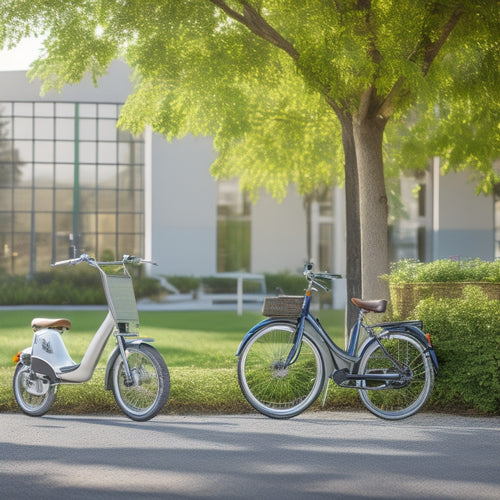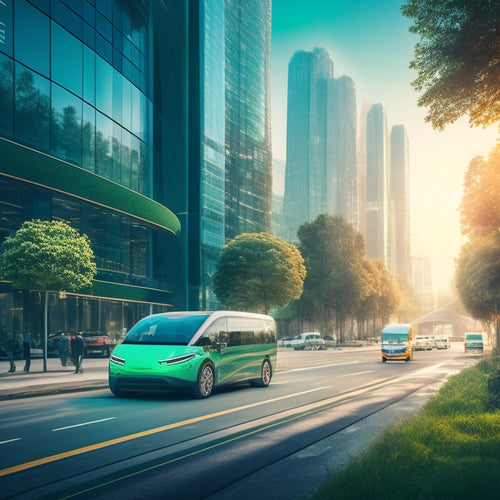
Electric Vehicles Revolutionize Urban Mobility Solutions
Share
As you navigate urban landscapes, you're likely to notice a transformative shift towards electric vehicles. These eco-friendly modes of transport are poised to revolutionize urban mobility solutions, reducing congestion by up to 20%, emissions by 70%, and operating costs while increasing efficiency and overall quality of life. With smart traffic management systems and green corridors, cities can optimize energy distribution, prioritize EVs, and create sustainable transportation hubs. As you explore the intersection of EVs and urban mobility, you'll uncover data-driven solutions that will reshape the urban ecosystem - and that's just the starting point for a more sustainable, efficient, and healthier urban future.
Key Takeaways
• Electric vehicles reduce congestion by up to 20% with efficient charging systems and smart traffic management, improving urban mobility.
• EVs decrease air pollution by up to 70% and greenhouse gas emissions, creating a healthier urban living environment.
• Strategic integration of EV charging infrastructure and renewable energy sources optimizes energy distribution and reduces emissions.
• Electric buses in public transit save up to 75% on fuel costs, reduce emissions, and improve air quality, enhancing urban mobility.
• EV adoption promotes sustainable transportation, shifting towards eco-friendly mobility solutions and reducing urban congestion.
Electric Vehicles for Urban Commuting
As you navigate through congested city streets, electric vehicles (EVs) emerge as a viable solution for urban commuting, offering a cleaner, quieter, and more efficient alternative to traditional gas-guzzlers. With governments offering attractive vehicle incentives, such as tax credits and rebates, the adoption of EVs is becoming increasingly appealing.
For instance, the US federal government offers a tax credit of up to $7,500 for the purchase of a qualifying EV. Additionally, many cities offer preferential parking and toll passes, making EV ownership even more enticing.
As you consider making the switch to an EV, you'll likely notice a significant change in your commuter behavior. With lower operating costs and reduced maintenance needs, EVs can help you save money and reduce your carbon footprint. Moreover, EVs require less frequent fueling, allowing you to focus on your daily commute rather than worrying about refueling.
Reducing Congestion With EV Infrastructure
As you explore the role of EV infrastructure in reducing congestion, you'll discover that efficient charging systems, smart traffic management, and green corridors development are key to optimizing urban mobility.
By implementing these solutions, cities can reduce traffic congestion by up to 20% and decrease travel times by an average of 15 minutes.
Efficient Charging Systems
By strategically deploying efficient charging systems, urban planners can greatly reduce congestion caused by EV owners waiting in line to recharge their vehicles. As you navigate the urban landscape, you'll notice a significant decrease in traffic jams and air pollution. By incorporating rapid charging stations, you can refuel your EV in under 30 minutes, making it a convenient option for daily commutes. Additionally, solar integration into these charging systems enables a sustainable and renewable energy source, reducing your carbon footprint.
When you opt for efficient charging systems, you're not only reducing congestion but also promoting a cleaner environment. According to recent studies, a 10% increase in EV adoption can lead to a 3% decrease in traffic congestion. By investing in smart charging infrastructure, cities can create a sustainable transportation ecosystem.
As you drive through the city, you'll notice a seamless shift to electric mobility, thanks to the strategic deployment of efficient charging systems.
Smart Traffic Management
You'll experience a significant reduction in travel time and congestion when smart traffic management systems, integrated with EV infrastructure, optimize traffic flow and routing in real-time. By analyzing traffic patterns and urban flow, these systems can predict and respond to congestion hotspots, dynamically adjusting traffic signals and routing to minimize delays.
With EVs providing real-time data on traffic conditions, smart traffic management systems can optimize traffic signal timing, reducing congestion by up to 20%. This not only reduces travel time but also decreases emissions and improves air quality.
Moreover, smart traffic management systems can prioritize EVs, giving them preferential access to roads and dedicated lanes, further reducing congestion and emissions. By leveraging EV infrastructure, smart traffic management systems can create a more efficient, sustainable, and connected urban transportation network.
As you navigate through the city, you'll enjoy a smoother, faster, and more environmentally friendly commute.
Green Corridors Development
Through strategic placement of EV charging infrastructure along high-traffic routes, cities can create 'green corridors' that reduce congestion and emissions while promoting widespread EV adoption. You'll be able to breathe easier, knowing that these corridors can decrease air pollution by up to 70%.
By integrating EV infrastructure into urban planning, cities can optimize land use and reduce the need for sprawling parking lots. This, in turn, can free up valuable space for green spaces, pedestrian zones, and community areas.
Here are some key benefits of green corridors:
-
Improved air quality: By reducing emissions, green corridors can decrease respiratory problems and other health issues associated with air pollution.
-
Enhanced urban planning: Strategically placed EV charging stations can influence land use decisions, promoting more efficient and sustainable urban development.
-
Increased EV adoption: By providing convenient and accessible charging infrastructure, cities can encourage more drivers to switch to electric vehicles.
- Reduced congestion: Green corridors can optimize traffic flow, decreasing travel times and reducing the frustration that comes with it.
Sustainable Transportation for Cities
Cities are increasingly adopting electric vehicles as a cornerstone of sustainable transportation, with many metropolitan areas already witnessing a significant reduction in greenhouse gas emissions and air pollutants. As you navigate through urban landscapes, you'll notice a shift towards eco-friendly mobility solutions.
Urban planning plays a pivotal role in this transformation, with cities designing infrastructure that accommodates electric vehicles. Mobility hubs, for instance, are being developed to provide convenient charging points, making it easier for you to own an electric vehicle.
The data speaks for itself: cities that have invested in sustainable transportation have seen a significant decrease in air pollutants. In fact, a study by the International Council on Clean Transportation found that cities that promote electric vehicles can reduce greenhouse gas emissions by up to 70%.
As you consider your next mode of transportation, you're likely to find that electric vehicles aren't only environmentally friendly but also cost-effective in the long run. With sustainable transportation at the forefront of urban planning, you can expect to see a significant shift towards a cleaner, healthier urban environment.
Electric Buses for Public Transit
Seventy percent of public transit agencies worldwide are already incorporating electric buses into their fleets, driven by the compelling data on reduced operating costs and emissions. As you consider the benefits of electric buses, you'll want to explore the advantages of integrating them into your public transit system.
Here are just a few reasons why electric buses are revolutionizing urban mobility:
-
Reduced Operating Costs: Electric buses can save up to 75% on fuel costs compared to traditional diesel buses, making them a cost-effective solution for public transit agencies.
-
Improved Air Quality: Electric buses produce zero tailpipe emissions, reducing air pollution and improving air quality for urban residents.
-
Enhanced Rural Accessibility: Electric buses can reach rural areas where traditional bus routes may not be feasible, expanding public transit options for underserved communities.
- Streamlined Bus Fleet Management: Electric buses can be easily integrated into existing bus fleets, allowing for seamless management and optimized route planning.
Green Cities With EV Charging Hubs
As you design and implement urban mobility solutions, you'll need to integrate EV charging hubs into your infrastructure, strategically locating them near high-demand areas, such as shopping centers, public parks, and transportation hubs, to guarantee seamless charging access for residents and visitors alike. This approach enables the creation of green cities, where eco-friendly transportation is prioritized. By doing so, you'll reduce congestion, improve air quality, and enhance the overall urban experience.
| Location | Charging Points | Capacity |
|---|---|---|
| City Center | 10 | 50 kW |
| Public Park | 5 | 22 kW |
| Transportation Hub | 20 | 100 kW |
| Shopping Mall | 15 | 60 kW |
Urban planning plays an important role in the successful integration of EV charging hubs. By incorporating these hubs into existing infrastructure, cities can become more sustainable, efficient, and environmentally friendly. As you develop your urban mobility solutions, consider the significance of eco-friendly transportation and the role EV charging hubs play in creating a greener, healthier urban environment.
Quiet Ride, Zero Emissions
By switching to electric vehicles, you'll not only reduce greenhouse gas emissions but also experience a quieter ride, thanks to EVs' electric motors, which produce much less noise pollution compared to traditional internal combustion engines. This silent cruising experience is a game-changer for urban mobility, making your daily commute more enjoyable and peaceful.
Here are some benefits you can look forward to:
-
Reduced noise pollution: Electric vehicles produce notably less noise, creating a more serene urban environment.
-
Eco-friendly transportation: EVs emit zero tailpipe emissions, making them an eco-friendly alternative to traditional gas-powered vehicles.
-
Improved passenger experience: The quiet ride and smooth acceleration of EVs provide a more comfortable and enjoyable ride for passengers.
- Enhanced urban planning: With decreased noise pollution, urban planners can design more livable cities with a focus on pedestrian-friendly spaces and green areas.
With electric vehicles, you can enjoy a quieter, more eco-friendly ride, contributing to a more sustainable urban mobility solution.
Urban Air Quality Improvement
As you shift to electric vehicles, you're not only reducing your carbon footprint, but you're also contributing to a significant improvement in urban air quality.
By migrating to EVs, you're reducing emissions that exacerbate respiratory issues and other health problems.
With cleaner city streets ahead, you're paving the way for a healthier urban living environment.
Cleaner City Streets Ahead
You'll breathe easier in cities where electric vehicles replace traditional gas-powered cars, reducing particulate matter, nitrogen oxides, and volatile organic compounds that contribute to urban air pollution by up to 70%. As the number of electric vehicles on the road increases, city dwellers can look forward to cleaner air and a healthier environment. This shift towards electric mobility is an important step in urban renewal and city beautification efforts.
Some of the benefits of electric vehicles in urban areas include:
- Reduced greenhouse gas emissions, contributing to a decrease in urban air pollution
- Lower operating costs, making electric vehicles a more affordable option for city dwellers
- Minimal noise pollution, creating a more peaceful urban environment
- Increased energy efficiency, reducing the strain on urban energy grids
With electric vehicles, city streets will become cleaner, quieter, and healthier.
As the world continues to urbanize, the significance of sustainable urban mobility solutions will only continue to grow. By adopting electric vehicles, cities can take a significant step towards a cleaner, more sustainable future.
Reducing Emissions Today
Electric vehicles can reduce emissions today by up to 70% in urban areas, where air pollution poses significant health risks, making them an essential component of urban air quality improvement strategies. You're probably wondering how this reduction is possible. The answer lies in the fact that electric vehicles produce zero tailpipe emissions, which means they don't emit harmful pollutants like particulate matter, nitrogen oxides, and volatile organic compounds.
| Emission Reduction Strategies | Effectiveness |
|---|---|
| Shift to Electric Vehicles | 70% reduction |
| Carbon Pricing | 30% reduction |
| Green Taxes | 20% reduction |
| Improving Public Transport | 15% reduction |
| Encouraging Active Transport | 10% reduction |
As you can see, shifting to electric vehicles has the highest impact on reducing emissions. Implementing carbon pricing and green taxes can also contribute significantly to reducing emissions. These strategies can be combined to achieve even greater reductions. By adopting these measures, you can breathe easier knowing that you're contributing to cleaner air and a healthier urban environment.
Healthier Urban Living
By incorporating electric vehicles into urban transportation systems, you can greatly reduce exposure to hazardous air pollutants, such as particulate matter, nitrogen dioxide, and ozone, which are responsible for a multitude of respiratory and cardiovascular diseases. This is essential for healthier urban living, as air pollution is a key contributor to urban health problems.
By shifting to electric vehicles, you can:
-
Reduce air pollutants by up to 70%, greatly decreasing the negative impact on urban air quality
-
Create cleaner air for citizens, particularly vulnerable populations such as children, the elderly, and those with pre-existing health conditions
-
Enhance urban wellness by providing a healthier environment for outdoor activities and recreation in green spaces
- Support the development of sustainable urban planning, prioritizing green spaces and pedestrian-friendly infrastructure
EVs for Last-Mile Delivery Solutions
Incorporating electric vehicles into last-mile delivery fleets can greatly reduce greenhouse gas emissions and operating costs, making them an appealing solution for companies looking to optimize their logistics.
As you consider shifting your delivery fleet to electric vehicles, you'll want to focus on fleet optimization to maximize efficiency. This includes optimizing routes, reducing idle time, and implementing smart charging systems. By doing so, you can increase your fleet's productivity while minimizing emissions.
When it comes to package security, electric vehicles offer a secure and tamper-evident solution. With features like GPS tracking and real-time monitoring, you can guarantee that packages are delivered safely and efficiently. Additionally, electric vehicles can be equipped with advanced security systems, such as cameras and alarms, to deter theft and vandalism.
Electric Motorcycles for Urban Traffic
How will you navigate congested urban roads more efficiently and sustainably? The answer lies in electric motorcycles, revolutionizing urban traffic like never before. As the world shifts towards a more environmentally conscious future, these eco-friendly rides are gaining traction.
Here are just a few reasons why electric motorcycles are changing the game:
-
Zero Emissions: Electric motorcycles produce zero tailpipe emissions, reducing urban air pollution and minimizing their carbon footprint.
-
Cost-Effective: With lower operating costs compared to traditional gas-guzzlers, electric motorcycles are an attractive option for commuters and ride-sharing services alike.
-
Increased Efficiency: Electric motorcycles boast instant torque, making them quicker and more agile in urban traffic.
- Redefining Motorcycle Culture: Electric motorcycles are reinvigorating the motorcycle culture, attracting a new wave of environmentally conscious riders who crave sustainability without sacrificing performance.
As the demand for sustainable transportation solutions grows, electric motorcycles are poised to play a significant role in shaping the future of urban mobility. By embracing this innovative technology, you'll be at the forefront of a transportation revolution that's redefining the way we navigate urban roads.
Smart City Infrastructure Development
As you navigate the urban landscape, you'll need smart city infrastructure that integrates seamlessly with electric vehicles, harnessing data-driven insights to optimize traffic flow, reduce congestion, and enhance overall mobility. This requires a holistic approach to urban planning, where infrastructure integration is key.
By leveraging advanced technologies like IoT sensors and real-time data analytics, cities can optimize traffic signal timing, lane management, and parking allocation to minimize congestion and reduce travel times.
Infrastructure integration is critical, as it enables the seamless flow of people, goods, and services. This involves synchronizing transportation systems, energy grids, and communication networks to create a cohesive and efficient urban ecosystem.
For instance, smart traffic management systems can adjust traffic signal timing in real-time to prioritize electric vehicles, reducing congestion and emissions. Additionally, integrated urban planning enables cities to optimize energy distribution, ensuring that electric vehicle charging infrastructure is strategically located and powered by renewable energy sources.
Frequently Asked Questions
Can Electric Vehicles Be Charged Using Renewable Energy Sources?
You can charge your electric vehicle using renewable energy sources by leveraging renewable infrastructure, such as wind or solar farms, and energy storage systems, like batteries, to guarantee a reliable and sustainable power supply.
How Do Electric Vehicles Reduce Greenhouse Gas Emissions in Cities?
"As you navigate city streets, you're probably wondering how electric vehicles reduce greenhouse gas emissions. Well, they do so by producing zero tailpipe emissions, and with Urban Planners integrating EV-friendly City Infrastructure, emissions plummet, making your urban oasis a cleaner haven."
What Is the Average Cost of Owning an Electric Vehicle?
You'll find that the average cost of owning an electric vehicle (EV) includes not only the sticker price, but also insurance premiums, which are often lower for EVs, and potential battery upgrades, which can range from $5,000 to $15,000.
Do Electric Vehicles Require More Maintenance Than Traditional Vehicles?
"An ounce of prevention is worth a pound of cure." You'll be relieved to know that electric vehicles require less maintenance than traditional ones, with fewer moving parts. You'll still need occasional battery replacements and roadside assistance, but overall, EVs are a low-maintenance choice.
Can Electric Vehicles Be Charged Using Home Electrical Outlets?
You can charge your EV using a standard home outlet, but be mindful of outlet safety and charging speed; a 120V outlet takes 24 hours for a full charge, while a 240V outlet takes just 4-6 hours.
Related Posts
-

What Are the Best Eco-Friendly Rides for Campus?
As you navigate your college campus, you have a wide range of eco-friendly ride options to choose from, including bic...
-

Why Opt for High-Efficiency Solar Panels Online?
You can greatly enhance your solar energy output and savings by upgrading to high-efficiency solar panels, which can ...
-

5 Best Online Stores for Green Vehicle Solutions
You're on the hunt for an eco-friendly ride, and online stores are a great place to start. You'll find top retailers ...


